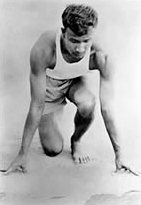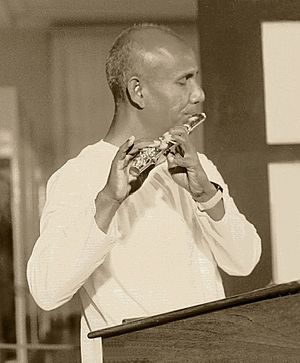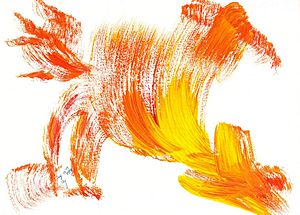Sri Chinmoy facts for kids
Quick facts for kids
Sri Chinmoy
|
|
|---|---|
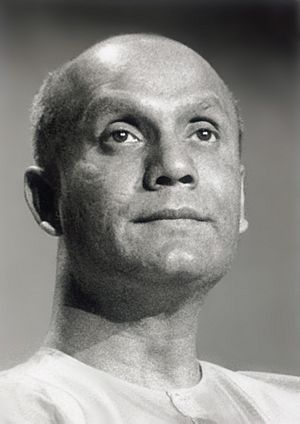 |
|
| Born |
Chinmoy Kumar Ghose
27 August 1931 |
| Died | 11 October 2007 (aged 76) |
| Nationality | Indian |
| Occupation | Spiritual teacher |
Chinmoy Kumar Ghose (born August 27, 1931 – died October 11, 2007), known as Sri Chinmoy, was a spiritual teacher from India. He taught meditation in the West. He moved to New York City in 1964.
Chinmoy started his first meditation center in Queens, New York. Over time, he had 7,000 students in 60 countries. He was a talented writer, artist, poet, and musician. He also held public events like concerts and meditations about inner peace. Chinmoy believed in finding God through prayer and meditation. He also encouraged athleticism, including running, swimming, and weightlifting. He organized many races and was an active runner himself. After a knee injury, he took up weightlifting.
Contents
Life Story of Sri Chinmoy
Growing Up in India
Chinmoy was the youngest of seven children. He was born in Shakpura, in what is now Bangladesh. He lost his father in 1943 and his mother a few months later. Chinmoy started meditating seriously when he was 11 years old.
In 1944, at age 12, Chinmoy joined his brothers and sisters at the Sri Aurobindo Ashram. This was a spiritual community in Pondicherry, India. His brother Chitta gave him the name Chinmoy, which means "full of divine consciousness."
He spent 20 years at the ashram. There, he practiced meditation and studied Bengali and English literature. He also took part in sports and worked in the ashram's small businesses. Chinmoy said he was the personal secretary to the ashram's General Secretary, Nolini Kanta Gupta, for about eight years. He translated Gupta's writings from Bengali into English.
Moving to the United States
Chinmoy said he felt a strong inner message to move to the United States in 1964. He wanted to help people in the West who were looking for spiritual meaning. With help from American sponsors, he moved to New York City.
He got a job as a junior clerk at the Indian consulate. Even without much formal education, he did well. His co-workers and bosses supported him. He was invited to give talks about Hinduism. He began speaking at universities and later at the United Nations.
In the late 1960s and early 1970s, Chinmoy gave many talks at universities across the U.S. These talks were about spiritual topics. In 1974, he spoke at 50 universities in 50 states. These talks became a book series. He also traveled to Europe, Asia, and Australia, giving lectures. He published many books, essays, spiritual poems, and plays.
In 1966, Chinmoy opened a Sri Chinmoy Center in Puerto Rico. Over the next few decades, centers opened worldwide. Eventually, there were 350 centers. In 1973, The New York Times newspaper wrote that Chinmoy was highly respected in India. They said he had reached a very high level of spiritual awareness.
During the 1970s, Chinmoy started playing and composing music on the flute and esraj. In 1984, he began giving free 'Peace Concerts' around the world. His largest concert was in Montreal, with 19,000 people attending.
Many musicians became his followers in America. These included Carlos Santana, John McLaughlin, and Roberta Flack. Chinmoy offered them a spiritual path that used music and poetry to express thanks to the Divine.
Santana and McLaughlin stayed with Chinmoy for several years. In 1973, they released an album called Love Devotion Surrender, based on Chinmoy's teachings. McLaughlin was a follower from 1970 to 1975. He formed the Mahavishnu Orchestra, named by Chinmoy. McLaughlin introduced Santana to Chinmoy. Santana and his wife were followers from 1972 to 1981.
Santana released three albums under the spiritual name Devadip, which Chinmoy gave him. This name means "Lamp of God" or "Light of God." In 2017, Santana said he was "really grateful for those 10 years I spent with that spiritual master."

Chinmoy believed in "self-transcendence." This means going beyond what you think are your limits. He often applied this idea to sports. Olympic gold medalist runner Carl Lewis learned to meditate from Chinmoy. Lewis said his connection with Chinmoy helped strengthen his Christian beliefs. In 2011, Lewis appeared in a documentary about Chinmoy's strength feats.
The Sri Chinmoy Marathon Team has swum the English Channel over 40 times. Chinmoy also supported ultra-distance running, mountain climbing, and long-distance cycling. In 2010, Ashrita Furman, who holds many Guinness World Records, said Chinmoy's meditation helped him achieve more than he expected.
In 1987, Sri Chinmoy started the Sri Chinmoy Oneness Home Peace Run. This is a symbolic relay run for peace through many countries. Runners carry a flaming torch that stands for harmony. Chinmoy called it a "grassroots effort for peace." The idea is that everyone on Earth wants peace.
In 1991, Chinmoy started 'Oneness Heart Tears and Smiles.' This group sends food and medicine to people in need. By 2007, it had helped 136 countries. It works with other groups and governments. It provides health, medical, and educational supplies. The 'Kids to kids' program encourages children to make packs of school supplies and toys for kids in other communities.
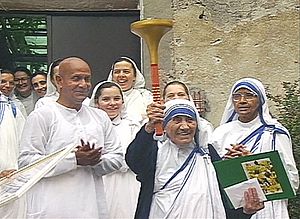
Chinmoy traveled widely and dedicated his activities to peace. He met with many world leaders. He was often called an ambassador of peace. Chinmoy met Mother Teresa five times. In 1994, Mother Teresa told him, "I am so pleased with all the good work you are doing for world peace." Chinmoy also met Diana, Princess of Wales, in 1997.
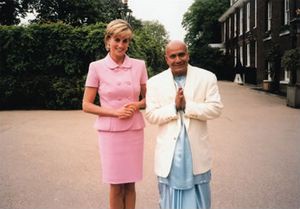
He did not charge money for his spiritual guidance or music concerts. He respected all religions and religious leaders. He had about 7,000 students during his lifetime. His path was a modern way of practicing yoga with a guru, or spiritual teacher. Chinmoy taught that you don't need to completely leave the world to make spiritual progress. Instead, you can gradually bring spiritual light into your everyday life.
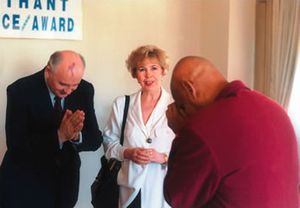
Chinmoy was a spiritual leader to thousands of followers worldwide until he died in 2007. From the mid-1960s, he lived in his main center in Queens, New York City. Many of his followers moved to the area to be near him.
Chinmoy died from a heart attack at his home in Jamaica, Queens, New York, on October 11, 2007. Mikhail Gorbachev wrote that his death was "a loss for the whole world." He added that Chinmoy would "forever remain a man who dedicated his whole life to peace."
Chinmoy's Teachings
Chinmoy taught that you could make quick spiritual progress by following a path of love, devotion, and surrender. He said divine love is about giving yourself and expanding your heart. This practice of loving God is called Bhakti Yoga. His path was not about leaving the world. Instead, it was a middle way where you change negative qualities that stop you from connecting with the Divine. Chinmoy taught that meditating on the heart helps bring out the soul's light.
Chinmoy said: "We are all seekers, and our goal is the same: to achieve inner peace, light and joy, to become inseparably one with our Source, and to lead lives full of true satisfaction."
A key part of Chinmoy's teachings is "self-transcendence." This means setting new goals and going beyond your old abilities and limits. This always brings joy. Self-transcendence is about becoming a better person, not competing with others. Chinmoy believed that our spirit is truly unlimited.
Chinmoy's philosophy was about accepting life. He believed that by sharing kindness and inspiration, and by serving others, the world can change and peace can be found.
He asked his students to eat a vegetarian diet and live a pure life. His path was influenced by Hinduism, but it welcomed people from all backgrounds.
Meditation Practices
Chinmoy taught many meditation techniques. These included ways to calm the mind, clear thoughts, and meditate on the spiritual heart. Chinmoy explained that if you keep your mind calm for ten or fifteen minutes, you can start to have new experiences. He said this practice of stilling the mind is the basis of all spiritual progress.
Chinmoy suggested meditating in the quiet early morning, before daily activities. He felt that running and physical fitness helped both inner spiritual life and outer active life. He encouraged his followers to run daily. Chinmoy believed running keeps the body fit and clears the mind. He felt it could also be a type of outer meditation.
United Nations Meditations
In 1970, Chinmoy began leading peace meditations twice a week at the United Nations. These were for UN delegates, staff, and other representatives. In 1976, he said, "The ideas of the United Nations are universal peace and universal brotherhood."
He led these peace meditations for 37 years. After his death, more than 700 UN officials and diplomats honored him at the UN headquarters in New York.
Respecting All Faiths
A very important part of Chinmoy's teaching was respecting other spiritual paths and religions.
Chinmoy worked to promote harmony among different faiths. He was invited to open the Parliament of the World's Religions in Chicago (1993) and Barcelona (2004) with a silent meditation. In 2004, he said, "During my opening meditation I am praying for the oneness of all religions."
Chinmoy said that even though he grew up in the Hindu tradition, his only religion was the "Love of God."
The Arts and Creativity
Chinmoy's Artwork
Chinmoy started painting in 1974. He called his art "Jharna Kala," which means "Fountain Art" in Bengali. His artwork was inspired by ideas of universal oneness and peace.
His abstract paintings used acrylics and pen drawings. Chinmoy used many different sponges, brushes, and colors. He painted in a unique, spontaneous, and mystical style. He said that when he painted, a creative flow came from his meditation. This allowed him to follow an inner inspiration.
In 1991, Chinmoy began a new series of artworks called "Dream-Freedom-Peace-Birds" or 'Soul Birds.' These bird drawings were often simple, like Zen sketches. Some had one bird, while others had hundreds in a large drawing. Chinmoy said the soul bird drawings stood for humanity's deep wish for freedom.
His art has been shown in many places around the world. These include the UNESCO offices in Paris, London's Victoria and Albert Museum, and the United Nations Headquarters.
Chinmoy's Music
Chinmoy composed thousands of short musical pieces. Most of them had lyrics in Bengali and English. Many of these are available online. He released two albums in Jamaica. In 1976, he released a meditative album called Music for Meditation.
Chinmoy also gave hundreds of free peace concerts. He performed in famous venues like London's Royal Albert Hall, New York's Lincoln Center and Carnegie Hall, and the Sydney Opera House. Chinmoy played many instruments at his concerts, including the flute, esraj, piano, and cello.
Chinmoy's Poetry
Chinmoy published over 1,300 books, including 120,000 poems. Many of these poems are aphorisms. An aphorism is a short, complete spiritual poem or verse. For example: "We are all truly unlimited, if we only dare to try and have faith." Chinmoy also published longer, more traditional poems. In 2001, he recited his poetry at the United Nations.
Many people have praised Chinmoy's inspiring writing. Archbishop Desmond Tutu wrote that Chinmoy's "sweet gems of wisdom" are "timeless truths full of encouragement, love and goodness."
Athletic Achievements
Running and Races
In 1977, the Sri Chinmoy Marathon Team was started. This team holds running, swimming, and cycling events worldwide. These range from fun runs to ultramarathons. Before this, in 1976, there was the Liberty Torch Run. In this relay race, 33 runners covered 8,800 miles across 50 states. This idea grew into the Sri Chinmoy Oneness-Home Peace Run in 1987. The Peace Run is usually held every two years.
In 1985, Chinmoy helped start the first "Sri Chinmoy Peace Mile" in Oxford, England. This is a measured mile where joggers can track their progress. Now, there are many "Peace Miles" around the world.
Many of Chinmoy's followers run daily to stay healthy and fit. Chinmoy himself continued to enter races until his 60s. After a knee injury, he focused on tennis and weightlifting.
Chinmoy also started the Self-Transcendence 6- & 10-day Races. These happen in Queens, New York, every April. He also founded the Self-Transcendence 3100 Mile Race. The New York Times called this race the "Mount Everest of ultramarathons."
The Self-Transcendence Marathon is a marathon held around Rockland Lake State Park in New York. Started in 2002, this event attracts about 900 runners from many countries. The Marathon takes place in the last week of August.
Weightlifting Feats
Chinmoy began weightlifting in 1985, when he was 54. His weightlifting included lifting many different objects and machines. He wanted to show that anything is possible if you can overcome your mind's limits. Bill Pearl, a former Mr. Universe, often hosted Chinmoy's strength shows. In 1999, Bill Pearl said that Chinmoy's feats of strength were "amazing." Chinmoy said he lifted weights to inspire others, especially older people. In 2006, he stated, "If I can inspire anybody in this world, then I feel that my life is meaningful."
In 1998, Chinmoy created a program called 'Lifting up the world with a Oneness Heart.' In this program, he lifted people who had inspired others. They stood on a platform above him. Chinmoy said he lifted them to show his appreciation for their achievements. He lifted about 7,000 people. These included Nelson Mandela, Desmond Tutu, Muhammad Ali, Sting, Eddie Murphy, Susan Sarandon, Roberta Flack, Yoko Ono, Jeff Goldblum, Richard Gere, and Helen Hunt. He also lifted twenty Nobel laureates and a team of sumo wrestlers.
In April 2011, a documentary film about Chinmoy's weightlifting, called Challenging Impossibility, was shown at the Tribeca Film Festival.
Awards and Honors
Here are some of the awards Sri Chinmoy received:
- Visva Sama Duta (Ambassador of Universal Peace): Given by Buddhist Monks in 1990. He was the first non-Buddhist to receive this honor in Sri Lankan history.
- Mahatma Gandhi Universal Harmony Award: Received with Coretta Scott King (wife of Martin Luther King Jr.) in 1994.
- Fred Lebow Award: Named after the founder of the New York City Marathon, given in 1996.
- Hindu of the Year (1997) and Hindu Renaissance Award: From Hinduism Today magazine in 1997. This honored him for teaching a yoga that blended old Hindu ideas with modern life.
- Pilgrim of Peace prize: From the 'International Center of Assisi for Peace among Peoples' in 1998.
- Mother Teresa Award: Presented by the President of Macedonia in 2001.
- Medal of Honor For the Cause of Peace and Friendship Among Nations: Given by the Vietnamese Ambassador to the United Nations in 2004.
- Honorary Doctorate of Humanities in Peace Studies: From Cambodia's International University in 2005.
- 2012 Class of Honorees, International Marathon Swimming Hall of Fame: This honored the Sri Chinmoy Marathon Team for swimming the English Channel 38 times.
See also
 In Spanish: Sri Chinmoy para niños
In Spanish: Sri Chinmoy para niños


